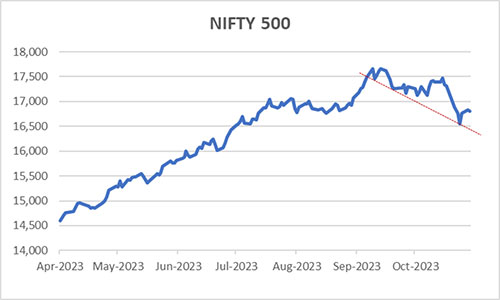The Indian equity market has registered a stupendous rally in the last 3 years driven by the optimism surrounding resilient domestic economic growth. Though there were bouts of sharp volatility and some consolidation during this period, the equity market continued its upward trajectory without any prolonged blip.
As a result, equity mutual funds, especially Mid Cap Funds and Small Cap Funds, performed extraordinarily well and rewarded investors handsomely.
However, the rising global uncertainties have threatened the near-term outlook of equities. Notably, the equity market has turned highly volatile off late and has witnessed some corrections on the back of geopolitical tensions in the Middle East, the hawkish stance of the US Federal Reserve, rising crude oil prices. Besides, some experts are of the opinion that a recession in the US is still not off the table.
Despite the robust economic growth in the past few quarters, India cannot remain fully insulated from global risks. Consequently, Foreign Institutional Investors (FIIs) have turned net sellers in the Indian equity market.
[Read: Why Mutual Fund NAVs Are Going Down and the Investment Strategy to Follow Now]
Weak global cues caused corrections in the Indian equity market

Data as of October 31, 2023
(Source: ACE MF, data collated by PersonalFN)
Going ahead too, global risks as well as the upcoming general elections in India are expected to keep equity investors on the edge.
So what can investors do in an environment characterised by elevated global risks?
Well, investors can benefit from an investment portfolio that is diversified across different asset classes. In other words, they may consider a hybrid strategy. Balanced Advantage Fund is one such hybrid mutual fund category that diversifies its portfolio across equity and debt to generate reasonable risk-adjusted returns.
The equity portion has the ability to generate superior long term returns that can potentially beat inflation, though they are highly volatile. On the other hand, the debt portion enables steady growth of capital at a relatively low risk compared to equities, and therefore it acts as cushion against volatility.
A combination of low correlated assets viz. equity and debt enable diversification in the portfolio by mitigating the various market risks and enabling stable growth of capital.
What are Balanced Advantage Funds?
As per SEBI’s definition, Balanced Advantage Funds are open-ended funds that dynamically invest in equity and debt. These funds have the flexibility to decide the allocation between equity and debt based on the prevailing market environment and their outlook. This differentiates Balanced Advantage Funds from other hybrid mutual funds such as Aggressive Hybrid Funds and Conservative Hybrid Funds that follow a static asset allocation model.
The fund managers of Balanced Advantage Fund analyse various factors such as macro-economic view, valuations, corporate earnings, interest rate view, inflation, among others, to allocate assets between equity and debt. Most fund managers use metrics such as the Price/Earnings (P/E) ratio, Price/Book Value (P/BV) ratio, Price Earnings to Growth (PEG) ratio, etc. to construct and manage the portfolio.
If a Balanced Advantage Fund is of the view that equity markets have turned expensive, it will trim the equity exposure, while simultaneously increasing its allocation in the debt segment. It will reinvest in equities when the valuations are reasonable.
It is noteworthy that most Balanced Advantage Funds invest minimum 65% of their assets in equities to benefit from the favourable tax treatment that equity-oriented mutual funds enjoy. When the markets are overvalued, Balanced Advantage Funds maintain the equity allocation by using hedging techniques such as Derivatives (F&O segment) and arbitrage opportunities to lower the risk. They also have the flexibility to invest some portion in REITs & InvITs, overseas equities, mutual fund units, cash and equivalents, etc.
How have Balanced Advantage Funds performed?
| Scheme Name | Absolute | CAGR | Ratio | |||||
| 6 Months | 1 Year | 2 Years | 3 Years | 5 Years | 7 Years | SD Annualised | Sharpe | |
| HDFC Balanced Advantage Fund | 13.40 | 19.61 | 16.84 | 29.34 | 16.29 | 14.02 | 12.92 | 0.49 |
| Tata Balanced Adv Fund | 7.24 | 10.17 | 8.54 | 15.13 | — | — | 6.73 | 0.39 |
| ICICI Pru Balanced Advantage Fund | 7.60 | 9.93 | 8.83 | 15.08 | 12.35 | 11.11 | 6.04 | 0.41 |
| Nippon India Balanced Advantage Fund | 8.29 | 9.27 | 7.52 | 14.98 | 11.60 | 10.78 | 7.39 | 0.35 |
| Aditya Birla SL Balanced Advantage Fund | 7.38 | 9.86 | 6.74 | 14.67 | 11.49 | 10.11 | 7.93 | 0.31 |
| Kotak Balanced Advantage Fund | 6.46 | 10.00 | 7.22 | 12.33 | 12.00 | — | 6.23 | 0.30 |
| SBI Balanced Advantage Fund | 7.93 | 12.79 | 9.44 | — | — | — | 6.20 | 0.19 |
| Category Average | 8.03 | 10.45 | 7.73 | 14.11 | 11.27 | 10.14 | 7.73 | 0.27 |
| CRISIL Hybrid 35+65 – Aggressive Index | 6.91 | 7.82 | 5.63 | 15.07 | 12.86 | 11.53 | 9.90 | 0.26 |
| NIFTY 500 – TRI | 11.16 | 9.87 | 6.64 | 21.84 | 15.16 | 13.48 | 15.11 | 0.31 |
| NIFTY 100 | 6.32 | 4.34 | 3.17 | 17.43 | 12.41 | 11.46 | 14.78 | 0.26 |
The securities quoted are for illustration only and are not recommendatory.
Data as of October 31, 2023; Direct plan – Growth option considered
Past performance is not indicative of future returns
(Source: ACE MF, data collated by PersonalFN)
What are the benefits of investing in Balanced Advantage Funds during a market high?
Balanced Advantage Funds aim to achieve capital appreciation by taking advantage of both equity and debt markets. Based on the market’s performance, these funds can swing between equity and debt to generate high growth from equities when the markets are favourable and steady income from debt when the equity markets are unfavourable. The dynamic allocation between equity and debt helps in minimising the risk. Thus, your portfolio benefits from diversification across asset classes.
Furthermore, as an investor, you do not have to worry about monitoring or rebalancing the portfolio as the fund manager of Balanced Advantage Fund does it for you. It is often observed that during a market high, many investors face the dilemma of whether to stay invested in equities in anticipation of further gains or to book profits because there is a possibility that the market may consolidate.
The fund managers, due to their market expertise have a better ability to forecast the market movement and accordingly shift allocation between asset classes. The active investment strategy of Balanced Advantage Funds saves investors from the challenges of readjusting their portfolio to benefit from the prevailing market conditions.
Moreover, investors can also save themselves from the tax implications of rebalancing the allocation between equity and debt. Since Balanced Advantage Funds have asset allocation in-built in its strategy, rebalancing happens in a tax-efficient way.
They also enjoy favourable tax treatment in the case of redemption of mutual fund units. Most schemes in the category usually invest 65% or more in equity and equity-related instruments. For such schemes long term capital gains are taxed at 10%, if the gains exceed Rs 1 lakh in a financial year.
And finally, Balanced Advantage Funds can offer better protection from the downside compared to pure equity funds, particularly in case of a severe market crash. As mentioned earlier, Balanced Advantage Funds achieve this by reducing exposure to equities and simultaneously increasing exposure to debt.
Thus, Balanced Advantage Funds have the potential to perform well during both upside and downside market conditions.
What are the risks involved in Balanced Advantage Funds?
Since SEBI has not prescribed any asset allocation limit for Balanced Advantage Fund, most schemes invest predominantly in equities to benefit from the favourable tax treatment accorded to equity investment. Due to substantial equity exposure, these funds are not immune from volatility. Additionally, Balanced Advantage Funds may underperform the market during a bull run.
That said, the risk involved in Balanced Advantage Fund is significantly lower compared to pure equity funds, and they may protect the downside risk better during bearish phases, thereby enabling decent risk-adjusted returns.
Notably, since each Balanced Advantage Fund follows its own unique investment strategy, scheme-specific risk may vary depending on the market cap bias and liquidity of the stocks in the case of equity portion of the portfolio, and credit quality and duration strategy in the case of debt portion.
Who should consider investing in Balanced Advantage Funds?
Balanced Advantage Funds are suitable for investors who are unsure about when and how much allocation should be shifted between equity and debt, such as novice investors. It can also be suitable for those looking to make a lump sum investment during uncertain market conditions because the scheme will decide the appropriate mix of equity and debt at all times.
With a major portion invested in equities, Balanced Advantage Funds can be susceptible to high volatility. Therefore, one should not assume that the category will offer assured or regular income. This makes it suitable only for investors with a moderate to high risk profile and an investment horizon of at least 3-5 years. When investing, prefer the SIP mode as it can help lower the overall volatility of the portfolio, while ensuring stable returns across market phases.
This article first appeared on PersonalFN here




